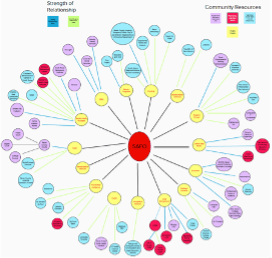Related Resources
This interactive tool highlights the aspects of communities associated with safe children and strong families. Learn more about yours.
LEARN MOREThe community mapping we [the San Antonio Field Office] worked on was to help foster youth reconnect with their community. This helps to define who they are and where they came from. Sometimes, just going back to the community brings back memories about their family and the culture they grew up in. … It also helps the social worker develop a better understanding of the youth.
– Staff person, San Antonio Field Office, Casey Family Programs
Casey Family Programs’ San Antonio Field Office provides clinical case management for youth and families who need help attaining or maintaining permanency, and for young adults transitioning from foster care. The team also engages with the community to prevent families from entering the foster care system. The field office has supported youth, families and the community since 1986.
Casey Family Programs’ Community Opportunity Map allows anyone to find child and family well-being data for any neighborhood across this nation to analyze, plan, and act alongside others to build Communities of Hope. The Community Opportunity Map has 30 indicators across five topic areas: child and family well-being, education, economy, housing, and accessibility (of food, internet, and transportation). The tool uses data from the U.S. Census Bureau’s American Community Survey and several other sources, covering states, counties, Congressional districts, cities, and ZIP codes in all 50 states as well as the municipios of Puerto Rico. Two-thirds of the indicators can be disaggregated by race and ethnicity. Using the tool, direct service providers like the San Antonio Field Office can better understand the neighborhoods where their clients live.

Prior to the pandemic, staff at the San Antonio Field Office received a brief orientation to the Community Opportunity Map to understand and learn how to navigate the tool. Then, they created their own process to explore the communities where the families they serve reside. The process included these steps:
As a result of this innovative approach to using the Community Opportunity Map, staff engaged with families differently and understood resources in a novel way. For example:
The pandemic created many challenges for effectively serving youth, families, and communities, and the Field Office’s work with the Community Opportunity Map was largely put on hold. Staff intend to re-engage and evolve their innovative work. This is an opportune time to leverage the tool as housing and resource availability have been exacerbated by the pandemic.